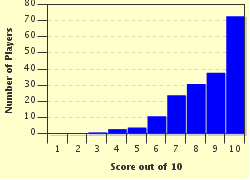Quiz Answer Key and Fun Facts
1. Can you work out the water related name of this unusually titled place in Worcestershire from the photo clue?
2. This short lane in London was once famous for its spices and tea. Does the photo clue help with its name?
3. Perhaps a lot of thirsty Australians live in this tourist site in Devon. You can perhaps work out its name from the photo clue given?
4. This site has a somewhat embarrassing name if you're a man. The photo clue may help. What is it?
5. How rude to call this lovely intelligent area of England such an insulting name. Can you work out its name from the photo clue?
6. Named after part of the human anatomy, what is this location in Kent?
7. Can you work out the name of this painful place from the photo clue?
8. You'll surely get this English location correct from the photo clue. What is it?
9. No more clues than this photo for this site in Leicestershire, England. Can you work it out?
10. What is the name of this comically named location in Dorset, England from the photo clue given?
Source: Author
Creedy
This quiz was reviewed by FunTrivia editor
spanishliz before going online.
Any errors found in FunTrivia content are routinely corrected through our feedback system.
